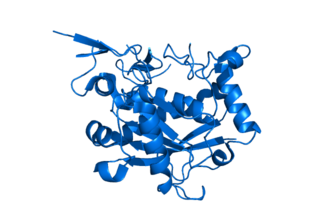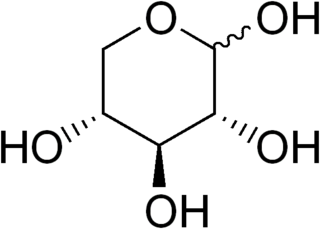
Keratin 18 is a type I cytokeratin. It is, together with its filament partner keratin 8, perhaps the most commonly found products of the intermediate filament gene family. They are expressed in single layer epithelial tissues of the body. Mutations in this gene have been linked to cryptogenic cirrhosis. Two transcript variants encoding the same protein have been found for this gene.

Heparan sulfate (HS) is a linear polysaccharide found in all animal tissues. It occurs as a proteoglycan in which two or three HS chains are attached in close proximity to cell surface or extracellular matrix proteins. In this form, HS binds to a variety of protein ligands, including Wnt, and regulates a wide range of biological activities, including developmental processes, angiogenesis, blood coagulation, abolishing detachment activity by GrB, and tumour metastasis. HS has also been shown to serve as cellular receptor for a number of viruses, including the respiratory syncytial virus. One study suggests that cellular heparan sulfate has a role in SARS-CoV-2 Infection, particularly when the virus attaches with ACE2.

Caspase-10 is an enzyme that, in humans, is encoded by the CASP10 gene.

Calcium/calmodulin-dependent protein kinase type IV is an enzyme that in humans is encoded by the CAMK4 gene.
In enzymology, a protein xylosyltransferase is an enzyme that catalyzes the chemical reaction in which a beta-D-xylosyl residue is transferred from UDP-D-xylose to the sidechain oxygen atom of a serine residue in a protein.

A disintegrin and metalloproteinase with thrombospondin motifs 1 is an enzyme that in humans is encoded by the ADAMTS1 gene.

Proto-oncogene tyrosine-protein kinase FER is an enzyme that in humans is encoded by the FER gene.

Eukaryotic translation initiation factor 2 subunit 2 (eIF2β) is a protein that in humans is encoded by the EIF2S2 gene.

Galactoside 2-alpha-L-fucosyltransferase 2 is an enzyme that in humans is encoded by the FUT2 gene. It affects the secretor status of ABO antigens.

Far upstream element-binding protein 2 is a protein that in humans is encoded by the KHSRP gene.

Lipid phosphate phosphohydrolase 1 also known as phosphatidic acid phosphatase 2a is an enzyme that in humans is encoded by the PPAP2A gene.

Aspartyl-tRNA synthetase, cytoplasmic is an enzyme that in humans is encoded by the DARS gene.

Beta-1,4-galactosyltransferase 7 also known as galactosyltransferase I is an enzyme that in humans is encoded by the B4GALT7 gene. Galactosyltransferase I catalyzes the synthesis of the glycosaminoglycan-protein linkage in proteoglycans. Proteoglycans in turn are structural components of the extracellular matrix that is found between cells in connective tissues.

Galactosylgalactosylxylosylprotein 3-beta-glucuronosyltransferase 3 is an enzyme that in humans is encoded by the B3GAT3 gene.

Xylosyltransferase 2 is an enzyme that in humans is encoded by the XYLT2 gene.

Diacylglycerol kinase delta is an enzyme that in humans is encoded by the DGKD gene.

Mitochondrial tRNA-specific 2-thiouridylase 1 is an enzyme that in humans is encoded by the TRMU gene.

A disintegrin and metalloproteinase with thrombospondin motifs 9 is an enzyme that in humans is encoded by the ADAMTS9 gene.

Xylosyltransferase are transferase enzymes which act upon xylose and are classified under EC 2.4.2.

Ribonuclease H1 also known as RNase H1 is an enzyme that in humans is encoded by the RNASEH1 gene. The RNase H1 is a non-specific endonuclease and catalyzes the cleavage of RNA via a hydrolytic mechanism.


















